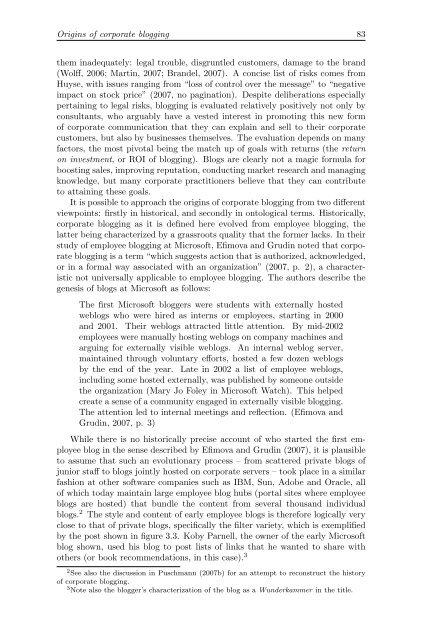The corporate blog as an emerging genre of computer ... - Oapen
The corporate blog as an emerging genre of computer ... - Oapen
The corporate blog as an emerging genre of computer ... - Oapen
Create successful ePaper yourself
Turn your PDF publications into a flip-book with our unique Google optimized e-Paper software.
Origins <strong>of</strong> <strong>corporate</strong> <strong>blog</strong>ging 83<br />
them inadequately: legal trouble, disgruntled customers, damage to the br<strong>an</strong>d<br />
(Wolff, 2006; Martin, 2007; Br<strong>an</strong>del, 2007). A concise list <strong>of</strong> risks comes from<br />
Huyse, with issues r<strong>an</strong>ging from “loss <strong>of</strong> control over the message” to “negative<br />
impact on stock price” (2007, no pagination). Despite deliberations especially<br />
pertaining to legal risks, <strong>blog</strong>ging is evaluated relatively positively not only by<br />
consult<strong>an</strong>ts, who arguably have a vested interest in promoting this new form<br />
<strong>of</strong> <strong>corporate</strong> communication that they c<strong>an</strong> explain <strong>an</strong>d sell to their <strong>corporate</strong><br />
customers, but also by businesses themselves. <strong>The</strong> evaluation depends on m<strong>an</strong>y<br />
factors, the most pivotal being the match up <strong>of</strong> goals with returns (the return<br />
on investment, or ROI <strong>of</strong> <strong>blog</strong>ging). Blogs are clearly not a magic formula for<br />
boosting sales, improving reputation, conducting market research <strong>an</strong>d m<strong>an</strong>aging<br />
knowledge, but m<strong>an</strong>y <strong>corporate</strong> practitioners believe that they c<strong>an</strong> contribute<br />
to attaining these goals.<br />
It is possible to approach the origins <strong>of</strong> <strong>corporate</strong> <strong>blog</strong>ging from two different<br />
viewpoints: firstly in historical, <strong>an</strong>d secondly in ontological terms. Historically,<br />
<strong>corporate</strong> <strong>blog</strong>ging <strong>as</strong> it is defined here evolved from employee <strong>blog</strong>ging, the<br />
latter being characterized by a gr<strong>as</strong>sroots quality that the former lacks. In their<br />
study <strong>of</strong> employee <strong>blog</strong>ging at Micros<strong>of</strong>t, Efimova <strong>an</strong>d Grudin noted that <strong>corporate</strong><br />
<strong>blog</strong>ging is a term “which suggests action that is authorized, acknowledged,<br />
or in a formal way <strong>as</strong>sociated with <strong>an</strong> org<strong>an</strong>ization” (2007, p. 2), a characteristic<br />
not universally applicable to employee <strong>blog</strong>ging. <strong>The</strong> authors describe the<br />
genesis <strong>of</strong> <strong>blog</strong>s at Micros<strong>of</strong>t <strong>as</strong> follows:<br />
<strong>The</strong> first Micros<strong>of</strong>t <strong>blog</strong>gers were students with externally hosted<br />
we<strong>blog</strong>s who were hired <strong>as</strong> interns or employees, starting in 2000<br />
<strong>an</strong>d 2001. <strong>The</strong>ir we<strong>blog</strong>s attracted little attention. By mid-2002<br />
employees were m<strong>an</strong>ually hosting we<strong>blog</strong>s on comp<strong>an</strong>y machines <strong>an</strong>d<br />
arguing for externally visible we<strong>blog</strong>s. An internal we<strong>blog</strong> server,<br />
maintained through voluntary efforts, hosted a few dozen we<strong>blog</strong>s<br />
by the end <strong>of</strong> the year. Late in 2002 a list <strong>of</strong> employee we<strong>blog</strong>s,<br />
including some hosted externally, w<strong>as</strong> published by someone outside<br />
the org<strong>an</strong>ization (Mary Jo Foley in Micros<strong>of</strong>t Watch). This helped<br />
create a sense <strong>of</strong> a community engaged in externally visible <strong>blog</strong>ging.<br />
<strong>The</strong> attention led to internal meetings <strong>an</strong>d reflection. (Efimova <strong>an</strong>d<br />
Grudin, 2007, p. 3)<br />
While there is no historically precise account <strong>of</strong> who started the first employee<br />
<strong>blog</strong> in the sense described by Efimova <strong>an</strong>d Grudin (2007), it is plausible<br />
to <strong>as</strong>sume that such <strong>an</strong> evolutionary process – from scattered private <strong>blog</strong>s <strong>of</strong><br />
junior staff to <strong>blog</strong>s jointly hosted on <strong>corporate</strong> servers – took place in a similar<br />
f<strong>as</strong>hion at other s<strong>of</strong>tware comp<strong>an</strong>ies such <strong>as</strong> IBM, Sun, Adobe <strong>an</strong>d Oracle, all<br />
<strong>of</strong> which today maintain large employee <strong>blog</strong> hubs (portal sites where employee<br />
<strong>blog</strong>s are hosted) that bundle the content from several thous<strong>an</strong>d individual<br />
<strong>blog</strong>s. 2 <strong>The</strong> style <strong>an</strong>d content <strong>of</strong> early employee <strong>blog</strong>s is therefore logically very<br />
close to that <strong>of</strong> private <strong>blog</strong>s, specifically the filter variety, which is exemplified<br />
by the post shown in figure 3.3. Koby Parnell, the owner <strong>of</strong> the early Micros<strong>of</strong>t<br />
<strong>blog</strong> shown, used his <strong>blog</strong> to post lists <strong>of</strong> links that he w<strong>an</strong>ted to share with<br />
others (or book recommendations, in this c<strong>as</strong>e). 3<br />
2See also the discussion in Puschm<strong>an</strong>n (2007b) for <strong>an</strong> attempt to reconstruct the history<br />
<strong>of</strong> <strong>corporate</strong> <strong>blog</strong>ging.<br />
3Note also the <strong>blog</strong>ger’s characterization <strong>of</strong> the <strong>blog</strong> <strong>as</strong> a Wunderkammer in the title.


